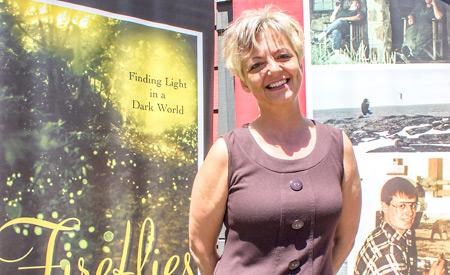In their short lives, delicate feathery winged fireflies produce a lambent flickering glow that bites back the darkness of many a soft summer evening—including those shared by Heather Gordon-Young and her brother Jim.
This bittersweet memory is the first scene in Heather’s first book, Fireflies: Finding Light in a Dark World, which takes readers along Jim’s tangled history with mental illness and addiction—struggles that would eventually lead to his death by suicide.
“I think if we lived in a world that was as open about beginning to talk about mental health issues and suicide and depression, [Jim] would have had a better run at having a life,” said Heather, speaking candidly of her brother—a gifted artist, who died at the young age of 26.
Heather said she often draws strength from the image of the firefly which she said reminds her to be the “light in somebody else’s dark world.”
Given her happy memory of her and her brother collecting fireflies while on holiday in Ontario, it is easy to see how Heather would take on this woodland creature as a sort of protective emblem from which to draw solace and strength after losing her brother.
Growing up in Prince George in the 1970s, Heather said Jim always struggled to find his place in the world.
“He was very anxious…[but] anxiety wasn’t something we talked about,” she said. “He felt things in a deep way and loved the world in a deep way. So sometimes that sensitivity also means that you feel things in a significant way.”
In addition to this sensitivity, Heather said Jim, who was private in this regard, might have suffered abuse at the hands of a teacher who later went to prison for sexually abusing other students at their school.
When things were going badly for Jim, Heather said he lost himself in his art, eventually becoming a prolific and talented wildlife artist.
“He talked about how he painted animals and birds…because they were pure, without malice,” she said of her brother who also lost himself in alcohol as he entered adulthood. “I think he was probably reflecting on how disappointed he was in some of the bad things that either happened to him or that he observed in the world.”
Heather said she often wonders what might have happened if she and her family would have been able to help—if at the time they had been able to escape their shame in his struggles with abuse and alcohol.
Living as they were in a northern town, her family was isolated from the mental health support they needed. And while Heather said Jim did consult doctors, she and her family instead turned, as was expected of a religious family, to the church for support.
Heather wishes her family could have spoken to the medical community the way they spoke to the church. “If that had been in place [Jim] would have probably had a much better life and be alive today and still be painting and making wonderful works of art.”
A former theological student, who left to “search for a better way to be human,” Heather explained how she saw writing the book as a “calling.”
First, however, in order to explore the issues of loss and mental illness, she had to overcome her need to find the answers to explain her brother’s death. A need, she said, which was firmly rooted in her religious background.
“The church tends to see itself as needing to be the one with the answers,” she said. “I had this expectation of myself, that I needed to have the answers…But it’s not about solving the problem so much as experiencing those parts of life that the book talks about.”
Through her book, Heather hopes to encourage churches to help parishioners liaise with the mental health support services in their communities.
Heather now works as executive director of Powell River Child, Youth and Family Services Society, where she manages a team of professionals helping families in a way her own family was not.
Erin Bradley, one of Heather’s colleagues, said she couldn’t help “getting emotional” in her capacity as parenting centre counsellor when she read the book.
“I really would love to have known Jim in the expertise that I have today,” said Bradley. “It would have been a very different journey if Heather’s family had been surrounded by people who could have potentially helped [him].”
To Sue Green, a youth justice counsellor at the centre, Gordon-Young’s struggle with a family member’s mental illness and suicide is a “universal” human story.
“It’s a personal story and something that a parent could read, or somebody struggling with mental health issues, and have things that they can pull from that,” said Green.
Inspired by Heather’s book, and her brother’s story as well as his art, the colleagues all pooled together to establish the Jim Young Fund for Mental Health, a non-profit foundation to raise awareness of mental health issues and eventually fund projects in rural and regional communities.
In addition to money from the sales of the book, the money above cost from print sales of Jim’s artwork, now assembled in an online gallery, will also go toward the foundation.
Fireflies will be launched on Friday, July 10, at the Revue Stage in Vancouver. For more information about the book, Jim’s art and the Jim Young Fund for Mental Health, readers can go to Heather's website.
Mental health and suicide
- Approximately 90 per cent of people who die by suicide were experiencing a mental health problem or illness.
- Approximately 500 suicides occur in BC each year.
- It is estimated that 11 people each day try to end their lives by suicide in Canada.
- Around the world, suicide is the second leading cause of death among 15 to 29-year-olds.
~ Crisis Intervention and Suicide Prevention Centre of BC



